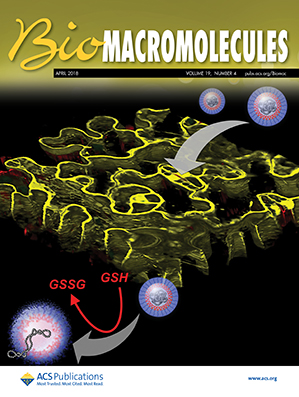3D-Printable Granular Hydrogel Composed of Hyaluronic Acid-Chitosan Hybrid Polyelectrolyte Complex Microgels
IF 5.4
2区 化学
Q1 BIOCHEMISTRY & MOLECULAR BIOLOGY
引用次数: 0
Abstract
When it comes to 3D printing of hydrogels, optimizing rheological properties is crucial to ensure (i) a smooth flow of the ink through the nozzle during printing and (ii) structural integrity postprinting. Granular hydrogels offer excellent printability due to their intrinsic yield-stress properties; however, they typically lack postprinting integrity in aqueous environments. To address this limitation, a novel approach is proposed to integrate the yield-stress behavior of granular hydrogels with polyelectrolyte complexes, which exhibit tunable mechanical properties and structural integrity in aqueous media. In this approach, hybrid microgels composed of chemically co-cross-linked hyaluronic acid–chitosan polyelectrolytes are prepared in a high-salt medium to shield electrostatic interactions and then jammed to form a printable granular hydrogel. By reducing the salt concentration below the critical threshold for electrostatic association, intra- and interparticle electrostatic interactions are activated, causing both the microgels and the granular hydrogel to shrink. This process yields a hydrogel with tunable stiffness, packing density, and dimensions. Overall, this strategy paves the way for the design of 3D hydrogel constructs with dynamic properties.
- Download: Download high-res image (137KB)
- Download: Download full-size image
由透明质酸-壳聚糖杂化聚电解质复合微凝胶组成的可3d打印颗粒水凝胶。
当涉及到水凝胶的3D打印时,优化流变特性对于确保(i)打印过程中墨水通过喷嘴的流畅流动和(ii)打印后的结构完整性至关重要。颗粒状水凝胶由于其固有的屈服应力特性而具有优异的印刷性;然而,它们通常在水性环境中缺乏印后完整性。为了解决这一限制,提出了一种新的方法,将颗粒水凝胶的屈服应力行为与多电解质配合物相结合,在水介质中表现出可调的机械性能和结构完整性。在这种方法中,在高盐介质中制备由化学共交联透明质酸-壳聚糖聚电解质组成的杂化微凝胶,以屏蔽静电相互作用,然后堵塞形成可打印的颗粒状水凝胶。通过将盐浓度降低到静电结合的临界阈值以下,激活颗粒内和颗粒间的静电相互作用,导致微凝胶和颗粒水凝胶收缩。这个过程产生的水凝胶具有可调的刚度、填充密度和尺寸。总的来说,这一策略为设计具有动态特性的3D水凝胶结构铺平了道路。
本文章由计算机程序翻译,如有差异,请以英文原文为准。
求助全文
约1分钟内获得全文
求助全文
来源期刊

Biomacromolecules
化学-高分子科学
CiteScore
10.60
自引率
4.80%
发文量
417
审稿时长
1.6 months
期刊介绍:
Biomacromolecules is a leading forum for the dissemination of cutting-edge research at the interface of polymer science and biology. Submissions to Biomacromolecules should contain strong elements of innovation in terms of macromolecular design, synthesis and characterization, or in the application of polymer materials to biology and medicine.
Topics covered by Biomacromolecules include, but are not exclusively limited to: sustainable polymers, polymers based on natural and renewable resources, degradable polymers, polymer conjugates, polymeric drugs, polymers in biocatalysis, biomacromolecular assembly, biomimetic polymers, polymer-biomineral hybrids, biomimetic-polymer processing, polymer recycling, bioactive polymer surfaces, original polymer design for biomedical applications such as immunotherapy, drug delivery, gene delivery, antimicrobial applications, diagnostic imaging and biosensing, polymers in tissue engineering and regenerative medicine, polymeric scaffolds and hydrogels for cell culture and delivery.
 求助内容:
求助内容: 应助结果提醒方式:
应助结果提醒方式:


